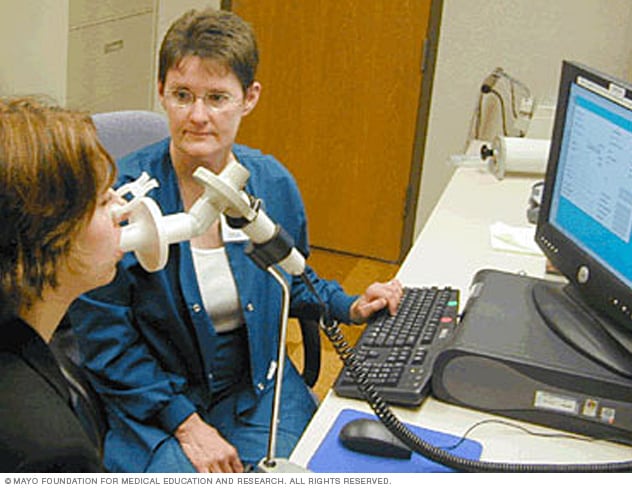诊断
为了诊断非感染性肺炎,医生或其他医疗护理专业人员会回顾您的病史和家族史。您诉说自己的症状并回顾您服用的任何药物以及先前接受的治疗,例如您接受过的癌症治疗。也可能询问您有关任何持续或反复接触灰尘、化学品、鸟类和霉菌来源的情况,尤其是工作、家庭或业余爱好中的接触。
医疗护理专业人员会进行体格检查,并使用听诊器听诊您呼吸时肺部的声音。
有助于诊断过敏性肺炎的一种选择是在几周内避免使用疑似环境物质,以观察症状是否改善。
为了区分非感染性肺炎与其他肺部状况,您可能需要进行一项或多项检查。
血液检测
可以做某些血液检查以帮助确诊。例如,血液检查可能能够判断您是否感染。血液检查可以检查是否有抗体提示接触过敏原。另一种血液检查(称为动脉血气)可以测量样本中的氧气和二氧化碳水平。
影像学检查
-
胸部 X 线检查。肺部影像可以显示炎症的部位和严重程度。X 线检查还可能排除导致您症状的其他状况,例如感染性肺炎。有时 X 线检查可能不会显示任何变化。
-
计算机体层成像(CT)。 CT 扫描通过结合从多个不同角度拍摄的 X 线影像来生成机体内部结构的影像。与胸部 X 线检查相比,CT 扫描可提供更详细的肺部变化信息。
CT 扫描也有助于了解肺部损伤的程度。
肺功能检查
进行肺功能检查,以确定肺部的工作情况:
-
肺量计法。在这项检查中,您需要通过一根与机器相连的管子快速地用力呼气。机器会测量肺部可以容纳的空气量,以及肺部吸入和呼出空气的速度。
-
肺容积检查。这项检查可测量肺部在呼吸过程中的不同时间能够容纳的空气量。
-
肺弥散功能检查。这项检查可以显示机体在肺与血液之间交换氧气和二氧化碳的能力。
-
脉搏血氧测定法。在这项简单的检查中,会在您的一根手指上放一个小型测量装置,测量您血液中的含氧量。血液中氧气的百分比含量称为血氧饱和度。医疗护理专业人员可能建议您进行 6 分钟步行试验加血氧饱和度检查。
成像和肺功能检查也可用于检查您的状况随时间推移的变化,并了解治疗效果。
 肺活量计
肺活量计
肺量计是一种诊断设备,可以测量您能够吸入和呼出的空气量以及深吸一口气然后完全呼出所花费的时间。
支气管镜检查
支气管镜检查是一种检查肺部和气道的程序。将一根细管(称为支气管镜)穿过鼻或口腔,从咽喉向下伸入肺部。
医生可能用盐水溶液冲洗肺的某一部分,收集肺细胞和其他材料。这种冲洗程序称为灌洗。
医生也可能会从您的肺部取出非常小的组织样本。有时,取出的组织样本太小,不足以作出正确的诊断。但这种形式的活检也可能用于排除其他状况。
外科肺活检
医生可能需要检查您肺部几个部位的更大组织样本,而这些组织无法通过支气管镜检查。可能需要外科类手术来采集这些样本。虽然手术活检是侵入性的,并存在并发症风险,但它可能是作出正确诊断的唯一方法。该手术可能采用微创手术的形式完成。
治疗
治疗方法视非感染性肺炎病因而定。
过敏性肺炎
如果非感染性肺炎是由化学物质刺激或过敏反应引起的,医疗护理专业人员可能会建议停止暴露于刺激肺部的物质。该措施应该有助于减轻症状。
减少暴露的方法包括:
-
避免接触诱发物质(如果已知)。如果状况严重,这甚至可能意味着要选择不同的工作或爱好。
-
穿戴防护装备。可过滤微粒的面部防护装置,如防花粉口罩或个人防尘呼吸器,可能会减少暴露。
-
改善通风。改善含有导致症状的物质的区域的空气流通,可能会减少暴露。
-
限制霉菌生长。清洁霉菌可能生长的地方,如热水浴缸、通风系统和加湿器,可避免暴露。清除被水损坏的地毯、家具和干墙。
皮质类固醇药物的作用是平息免疫系统对刺激的反应。这可以减轻肺部炎症。皮质类固醇通常以药片形式服用,服用时间有限。长期服用皮质类固醇会增加感染的风险,并与称为骨质疏松的骨骼变薄有关。可以使用其他减轻免疫系统反应的药物。
有时,使用吸入器吸入皮质类固醇可能会有帮助。将这些药物吸入肺部。这些药物可以减轻气道炎症,从而使呼吸更顺畅。
支气管扩张剂通常也是以吸入器形式提供的药物。这些药物可放松气道周围的肌肉,有助于缓解咳嗽,使呼吸更顺畅。
药物性非感染性肺炎
药物性非感染性肺炎的治疗取决于症状的严重程度。如果症状轻微,可能不需要任何治疗。如果症状严重,则主要使用皮质类固醇治疗,但有时其他减轻免疫系统反应的药物也可能有帮助。有时,医疗护理专业人员可能会决定停用或更换引起炎症的药物。
放射性非感染性肺炎
如果症状轻微,可能不需要治疗放射性非感染性肺炎。严重症状通常使用皮质类固醇治疗。
任何原因引起的非感染性肺炎的治疗方案
当非感染性肺炎严重时,治疗方法还可能包括:
-
氧疗。如果呼吸非常困难,可能需要通过面罩或与鼻孔吻合的带有尖端的塑料管进行氧疗。可以在睡眠或运动时使用氧气。但有些人全天都需要氧气。随身携带一小罐氧气或使用便携式制氧机有助于增强您的活动能力。
-
肺康复治疗。肺康复治疗可以帮助您控制症状,提高进行日常任务的能力。
-
肺移植。严重的肺损伤可能需要进行肺移植。
生活方式与家庭疗法
诊断为非感染性肺炎,可能意味着您必须改变自己的生活方式以保护自身健康。您需要尽可能避开已知诱因。
不要抽烟。抽烟会使肺损伤加重。如果需要帮助戒烟,请咨询医疗护理专业人员。
如果您的工作职责使您暴露于刺激肺部的物质,请向医疗护理专业人员和工作主管咨询自我保护方法。如果某种爱好会引发这种问题,您可能需要改变爱好。
准备您的预约
您可能要先看家庭医疗护理专业人员。然后,您可能会被转诊给一位具有肺部状况专业知识的医生(称为肺科医生)。
您可以做什么
就诊前,请列出一个列表,其中包括:
- 您的症状,包括症状何时开始,以及是否有任何事物看似加重或减轻症状。
- 您的工作活动中可能涉及的所有工作和任何暴露。
- 您经常进行的爱好可能会使您暴露于可能刺激肺部的物质。
- 您已存在的医疗问题及其治疗。
- 您父母或兄弟姐妹存在的医疗问题。
- 您服用或近几年服用过的所有药物、维生素、草药和补充剂。包括相应剂量。
- 要向医疗护理专业人员咨询的问题。
要询问的问题可能包括:
- 我的症状可能是由什么原因引起?
- 我需要做哪些检查?
- 您推荐哪种治疗方法?
- 我还有其他健康状况。我的非感染性肺炎会对这些健康状况有什么影响?
- 我需要遵守什么限制吗?
就诊期间,如有其他问题,您可以随时询问。
医生可能做些什么
医疗护理专业人员可能会问您一些问题,例如:
- 您目前或者之前抽烟吗?
- 您从事哪类工作或有哪些爱好?
- 您的呼吸症状是否与您的工作或爱好安排相关,症状加重还是好转?
- 您家有热水浴缸或加湿器吗?
- 您周围有鸽子或宠物鸟吗?
请做好回答这些问题的准备,以便留出时间讨论您最关心的事情。
Nov. 26, 2024